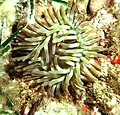| Actiniidae | |
|---|---|
 | |
| Anemonia sulcata | |
| Scientific classification | |
| Domain: | Eukaryota |
| Kingdom: | Animalia |
| Phylum: | Cnidaria |
| Class: | Hexacorallia |
| Order: | Actiniaria |
| Superfamily: | Actinioidea |
| Family: | Actiniidae Rafinesque, 1815 |
| Genera | |
See text | |
Actiniidae is the largest family of sea anemones, to which most common, temperate, shore species belong. Most members of this family do not participate in symbioses with fishes. Three exceptions are the bubble-tip anemone (with anemonefish and certain cardinalfish), snakelocks anemone (with Incognito goby) and Urticina piscivora (with painted greenling). [1] [2] [3]
Contents
The systematics of Actiniidae is often quite difficult. The problem with identification of genera within this family is that most species are readily distinguishable when alive but when fixated lose their color and some other features. Arrangement of tentacles is important in defining genera for Actiniaria families. There may be one tentacle per space between mesenteries or there may be more than one tentacle between each two mesenteries. Members of the family Actiniidae have one tentacle per space.


